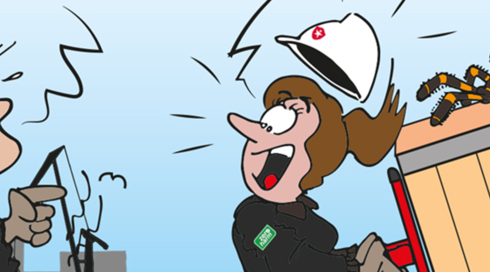2
Being a global leading recruitment provider, Atlas Professionals provides personnel for innovative projects at the frontier of offshore energy, marine and renewables. One of those innovative projects is the non-profit organisation The Ocean Cleanup, which designs and develops the first feasible method to rid the world’s oceans of plastic. Gordon Foot, a seasoned professional who joined Mission 3 of The Ocean Cleanup as a Client Representative via Atlas Professionals, shares his experience in an interview.
The Great Pacific Garbage Patch
“I was called in to be the liaison between The Ocean Cleanup’s headquarters in Rotterdam and the team offshore and to oversee and ensure safe execution of the Mission’s scope of work,” says Gordon Foot. With his 30 years’ experience in maritime operations supervision, he ensured the three team members of The Ocean Cleanup that joined the offshore crew remained safe and happy. “Most of the staff of The Ocean Cleanup are not seafarers, but office based. Everything that you are used to in an office environment changes because a ship presents a dynamic working environment, even more so in rough weather. On top of that, it can be quite alien out here and presents different working challenges, spending six weeks in such a remote location as the Great Pacific Garbage Patch,” he says.
“The team did really well and quickly picked up on some seafarer etiquette such as being self-sufficient with laundry, tidying up cups after yourself, how to conduct yourself appropriately when on the busy bridge and the nuances of interacting with the vessel’s officers and crew,” says Gordon. The experienced Client Representative joined the crew through international recruitment company Atlas Professionals to the Great Pacific Garbage Patch on Mission 3. It is during this Mission that The Ocean Cleanup was further testing System 001/B and, after one year of testing, has succeeded in developing a self-contained system that is using the natural forces of the ocean to passively catch and concentrate plastic.
Excellent safety culture
One of Gordon’s roles on the Mission was to ensure Zero Harm, getting everybody back in the state they arrived – injury free. “We were in a remote area in the middle of nowhere and this fact has to be taken seriously. Acting in a safe manner and professionally at all times is a paramount concern, because even things like dental problems or minor medical issues can have a significant impact.” Gordon put across the safety implications of extended mission operations in remote locations like the Great Pacific Garbage Patch. This included how the team should conduct themselves whilst interacting with the Maersk crew, ensuring they were appropriately briefed and their tasks risk assessed, whilst making sure that all their tasks and challenges were also going to be fun.
Commenting on the excellent safety culture on board, Gordon says: “Although every ship and company will operate at different levels, they’ve got a really mature safety culture onboard, everyone has a voice and together we’ve got each other’s backs. We have a good buddy system, good risk assessment linked with concise method statements and I’m proud that all the operations we’ve conducted out here have been spot on,” says Gordon, who thoroughly enjoyed the different challenges of working with The Ocean Cleanup.
Cherry on the cake
Gordon, who has been working at sea since the age of seventeen, could not wait to pack his bags when he saw the position for The Ocean Cleanup become available. “Having spent half my life under the water as a submariner and diver and half my life on top, I’ve seen the amount of plastics that are in the oceans and how they have mounted over the years. I’ve seen moray eels, lobsters and turtles in nets and plastics and things like that,” he says.
Joining the Mission has been the cherry on the cake for the Client Representative. “I’ve worked in remote places like Ascension Island, the Aleutian Islands and Alaska before, but even this tops that. It is a privilege to be able to give something back to the oceans with an environmental project like The Ocean Cleanup, which brings us one step forward to ridding the oceans of plastics with every Mission,” concludes Gordon.
About The Ocean Cleanup
The Ocean Cleanup develops advanced technologies to rid the world’s oceans of plastic. Founded in 2013 by Boyan Slat, The Ocean Cleanup now employs approximately 90 engineers and researchers. The foundation is headquartered in Rotterdam, the Netherlands. Instead of going after plastic debris with vessels and nets, The Ocean Cleanup plans to deploy a fleet of long floating barriers that act like an artificial coastline, enabling the winds, waves, and currents to passively catch and concentrate the plastic. Once fully operational, the full fleet of passive collection systems is expected to remove 50% of the Great Pacific Garbage Patch every five years.
After years of conducting reconnaissance expeditions, scale model tests and the deployment of prototypes on the North Sea, the first ocean cleanup systems were deployed into the Great Pacific Garbage Patch in 2018 and 2019. Once proof of technology is achieved, The Ocean Cleanup can commence full-scale cleanup and begin removing vast amounts of ocean plastic that have been accumulating in the ocean for decades. The Ocean Cleanup is working with partners to design processes to convert recovered ocean plastic into valuable raw materials and durable products. Complementary to its approach to solve the legacy problem of plastic in the ocean garbage patches, the organization developed the Interceptor™ technology to help prevent plastic garbage from entering the ocean in the first place.
.png)
.png)


